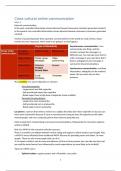Summary
Summary of cross cultural online communication (IBC), Radboud University
- Course
- Institution
This is a summary of the first period of the cross cultural online communication course. It includes notes from the book, the lectures and powerpoints, and the articles that have to be learned in addition. I obtained a 9.2 on the exam with this summary.
[Show more]



